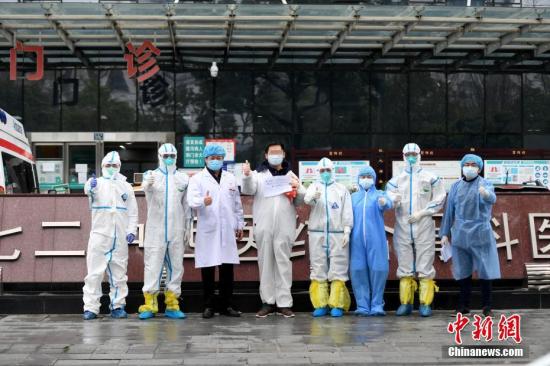China News Service, March 5. According to the website of the National Health and Medical Commission, the National Health and Medical Commission recently issued a "Rehabilitation Plan for New Crown Pneumonia Discharged Patients (Trial)" (hereinafter referred to as "Rehabilitation Plan"). The "Rehabilitation Plan" specifies the rehabilitation place for patients after discharge, and provides special explanations on the contraindications for rehabilitation, the situation that patients need to be stopped immediately during treatment, the conditions that patients should pay attention to when they are combined with other diseases, and the issues that elderly patients need to pay attention to Severe and critically ill patients and light and normal patients have different requirements for rehabilitation after discharge.
Data map: On February 21, a patient with neonatal pneumonia in Wuhan was cured and discharged. The picture shows a group photo of discharged patients and medical staff. Photo by Anyuan China Press
The goal of the "Rehabilitation Program" is to improve the symptoms of dyspnea and dysfunction in patients with new coronary pneumonia discharge, reduce complications, alleviate anxiety and depression, reduce disability, maximize the ability of daily living and improve the quality of life.
The "Rehabilitation Plan" is applicable to patients discharged from New Coronary Pneumonia.
The "Rehabilitation Plan" specifies the rehabilitation function assessment of patients with new coronary pneumonia discharge, including: respiratory function assessment, physical function assessment, psychological function assessment, daily living ability assessment, six-minute walking test, etc. At the same time, the rehabilitation methods for patients with new coronary pneumonia were clarified, including four parts: respiratory function training, physical function training, psychological rehabilitation intervention, and daily life ability training.
The "Rehabilitation Plan" pointed out that when the patient experienced obvious fatigue during treatment and could not be relieved after rest, chest tightness, chest pain, dyspnea, severe cough, dizziness, headache, unclear vision, palpitations, sweating, standing instability, etc. The situation should immediately stop rehabilitation, re-evaluate and adjust the treatment plan.
In addition, the "Rehabilitation Plan" pointed out that after discharge of patients with severe or critical illness, depending on the actual situation of local rehabilitation medical work, they can recover after discharge from designated rehabilitation medical institutions and primary medical and health institutions. After being discharged from hospitals with light or ordinary patients, the community and home should take appropriate rest and exercise to restore physical fitness, physique and immunity as much as possible.

